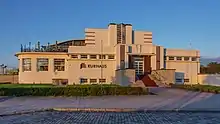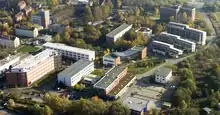Warnemünde
Warnemünde (German pronunciation: [vaʁnəˈmʏndə], literally Mouth of the Warnow) is a seaside resort and a district of the city of Rostock in Mecklenburg, Germany. It is located on the Baltic Sea and, as the name implies, at the estuary of the river Warnow. Warnemünde is one of the world's busiest cruise ports.
Warnemünde | |
|---|---|
District of Rostock | |
 View of Warnemünde | |
 Warnemünde | |
| Coordinates: 54°10′N 12°05′E | |
| Country | |
| Region | Mecklenburg-Vorpommern |
| Area | |
| • Total | 5.57 km2 (2.15 sq mi) |
| Population | |
| • Total | 8,441 |
| Postal code | 18119 |
| Area code(s) | 0381 |
| Website | www.warnemuende.de |
History
Founded in about 1200, Warnemünde was for centuries a small fishing village with minor importance for the economic and cultural development of the region. In 1323 Warnemünde lost its autonomous status as it was purchased by the city of Rostock in order to safeguard the city's access to the Baltic Sea. It was not until the 19th century that Warnemünde began to develop into an important seaside resort. Today Warnemünde has approximately 8,400 inhabitants.
Economy
Once completely dependent on the fishing industry, Warnemünde's economic alignment has shifted inevitably from the primary to the secondary and tertiary sector. Besides the Nordic Yards Warnemünde ship yard (the former Warnowwerft), the economy largely depends on tourism. The construction of a modern cruise line centre in 2005 has contributed crucially to Warnemünde's establishment as the most important harbour for cruise line ships in Germany.
Warnemünde was formerly the site of the original LFG aircraft factories during World War I. Prior to World War II a number of other companies, mostly related in some way to the now bankrupt LFG, started operations in the area. These included Heinkel and Arado Flugzeugwerke. The factories and surrounding living areas were bombed several times during the war. Many of these factories were used to form Warnow Werft.

Sights


Being a centre of maritime traffic, the district of Warnemünde comprises numerous navigational aids, the oldest being the lighthouse, built in 1897, and still currently in use. In the summer, the tower, approximately 37 metres (121 ft) high, allows visitors to enjoy an impressive view over the Baltic Sea and the northern districts of Rostock. Warnemünde's other famous landmark, the nearby Teepott (Teapot in German) with its Hyparschale curved roof, is an interesting living example of East German architecture. Built in Bauhausstile and opened for the first time in 1926, it burned down at the end of World War II. Rebuilt in the 1960s with a curved roof and renovated in 2002, it today houses various restaurants.
_2006-09-21.jpg.webp)
In the vicinity of the canal called der Alte Strom (Old Channel), with its various restaurants, pubs and traditional fishing boats, regional specialities are offered in a fish market. Edvard Munch House, where the Norwegian painter of The Scream lived from 1907 to 1908, is at Am Strom 53. The Warnemünde Church was built on the western edge of the town in 1866 and consecrated in 1871.
Warnemünde's large, sandy beaches are the broadest on the German Baltic Sea coast and stretch out over a length of 3 kilometres (1.9 mi).
There is a simple 1:1 billion scale model of the Solar System, the Warnemünder Planetenwanderweg,[1][2] with a 1.4m diameter sphere as a model of the Sun installed near the light house, and signs with true scale depictions of the planets at the appropriate distances of their orbits along a coastal walking trail westwards. Some of these signs are over a kilometre apart, and the total length of the Planetenwanderweg is close to 6 km (5,870m). The model includes Pluto and has not been updated since Pluto was reclassified as a dwarf planet. Walking along the Planetenwanderweg allows hikers to get an intuitive idea of the relative distances between the orbits of the planets and the Sun.
Climate
The district of Warnemünde has a Baltic-influenced oceanic climate (Cfb) according to the Köppen climate classification system.
| Climate data for Rostock (Warnemünde), elevation: 10 m, 1961-1990 normals and extremes | |||||||||||||
|---|---|---|---|---|---|---|---|---|---|---|---|---|---|
| Month | Jan | Feb | Mar | Apr | May | Jun | Jul | Aug | Sep | Oct | Nov | Dec | Year |
| Record high °C (°F) | 12.4 (54.3) |
17.0 (62.6) |
22.3 (72.1) |
29.2 (84.6) |
29.5 (85.1) |
32.6 (90.7) |
33.0 (91.4) |
34.5 (94.1) |
29.5 (85.1) |
24.4 (75.9) |
19.5 (67.1) |
15.5 (59.9) |
34.5 (94.1) |
| Average high °C (°F) | 2.2 (36.0) |
2.9 (37.2) |
6.1 (43.0) |
10.0 (50.0) |
15.6 (60.1) |
18.9 (66.0) |
20.5 (68.9) |
20.7 (69.3) |
17.5 (63.5) |
12.9 (55.2) |
7.5 (45.5) |
3.9 (39.0) |
11.6 (52.9) |
| Daily mean °C (°F) | 0.2 (32.4) |
0.7 (33.3) |
3.1 (37.6) |
6.3 (43.3) |
11.3 (52.3) |
15.0 (59.0) |
16.8 (62.2) |
16.7 (62.1) |
13.9 (57.0) |
9.9 (49.8) |
5.3 (41.5) |
1.9 (35.4) |
8.4 (47.1) |
| Average low °C (°F) | −1.9 (28.6) |
−1.4 (29.5) |
0.7 (33.3) |
3.6 (38.5) |
8.0 (46.4) |
11.8 (53.2) |
13.7 (56.7) |
13.5 (56.3) |
11.0 (51.8) |
7.3 (45.1) |
3.2 (37.8) |
−0.1 (31.8) |
5.8 (42.4) |
| Record low °C (°F) | −17.8 (0.0) |
−18.1 (−0.6) |
−13.5 (7.7) |
−3.1 (26.4) |
0.0 (32.0) |
2.5 (36.5) |
7.3 (45.1) |
6.5 (43.7) |
3.4 (38.1) |
−1.3 (29.7) |
−9.3 (15.3) |
−15.6 (3.9) |
−18.1 (−0.6) |
| Average precipitation mm (inches) | 46 (1.8) |
31 (1.2) |
40 (1.6) |
42 (1.7) |
47 (1.9) |
59 (2.3) |
71 (2.8) |
59 (2.3) |
54 (2.1) |
42 (1.7) |
52 (2.0) |
48 (1.9) |
591 (23.3) |
| Average precipitation days | 10 | 8 | 10 | 9 | 8 | 9 | 10 | 9 | 9 | 9 | 11 | 11 | 113 |
| Mean monthly sunshine hours | 37.2 | 64.4 | 108.5 | 174 | 244.9 | 246 | 232.5 | 226.3 | 156 | 105.4 | 54 | 37.2 | 1,686.4 |
| Source: HKO[3] and NOAA[4] | |||||||||||||
Culture and sport


There are a lot of musicians and bands in Warnemünde who are involved in cultural events.
- De Klaashahns
- De Plattfööt
- TonArt
- Irish Coffee
- Heide Mundo
Sport
Because of the weak current and good sailing conditions, Warnemünde is a major sailing area in Germany. The beach is especially good for kitesurfing, windsurfing, underwater diving, swimming and nordic walking. In the summertime there are a lot of international competitions like the yearly sailing event Warnemünde Week in July. Many people flock to Warnemunde to witness these competitions.
Personalities
- Stephan Jantzen (1827–1913), seaman, commander of the Pilots and Rescue Team
- Ernst Heinkel (1888–1958) he established the Heinkel-Flugzeugwerke company at Warnemünde in 1922, a prominent Nazi.
- Karl Heinz Robrahn (1913–1987), lyricist
- Maria Hasse (1921 in Warnemünde – 2014), a German mathematician who became the first female professor in the faculty of mathematics and science at TU Dresden .
- Klaus Lass (born 1950), singer and songwriter, city-guide
- Matthias Hahn (born 1965), former handball player and currently coach.
References
- Karge, W; Münch, E; Schmied, H (1996). Die Geschichte Mecklenburgs (in German). Rostock: Hinstorff. ISBN 978-3-356-00527-1. OCLC 75680668.
- Kloock, Joachim; Schade, A (2005). Rostock mit Warnemünde (in German). Rostock: Redieck und Schade. ISBN 978-3-934116-43-6. OCLC 181531749.
- Fleury, Alain (2007). Le voyage à Warnemünde (in French). Paris: Harmattan. ISBN 978-2-296-01737-5. OCLC 77493852.
Notes and inline references
- "Warnemünder Gedenktafeln & Warnemünder Planetenwanderweg". www.svenlorenzen.de. Retrieved 24 April 2018.
- http://www.einfach-meer-warnemuende.de/informieren/warnemuende-infos/warnemuender-planetenweg/unser-sonnensystem-in-modellform (in German)
- "Climate Statistics for Warnemünde, Germany". Archived from the original on 9 April 2009. Retrieved 6 May 2012.
- "Rostock-Warnemunde (10170) - WMO Weather Station". NOAA. Retrieved 28 January 2019. Archived January 28, 2019, at the Wayback Machine
External links
| Wikimedia Commons has media related to Warnemünde. |